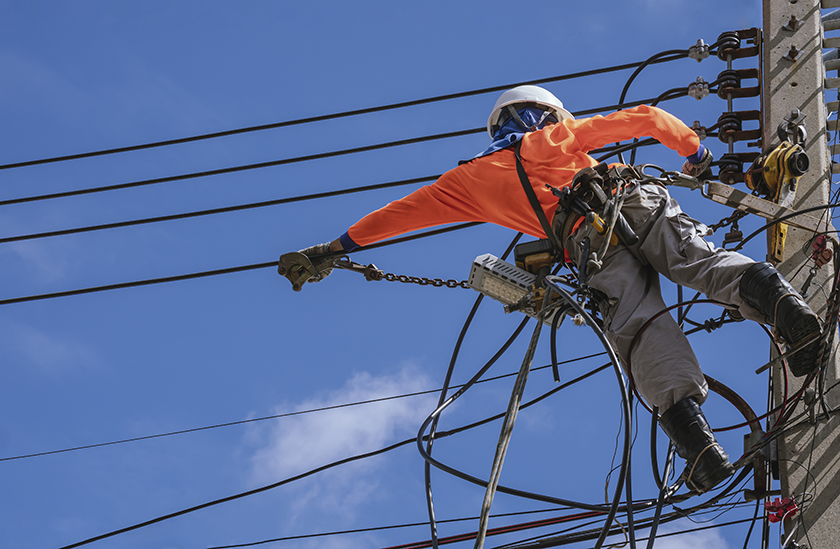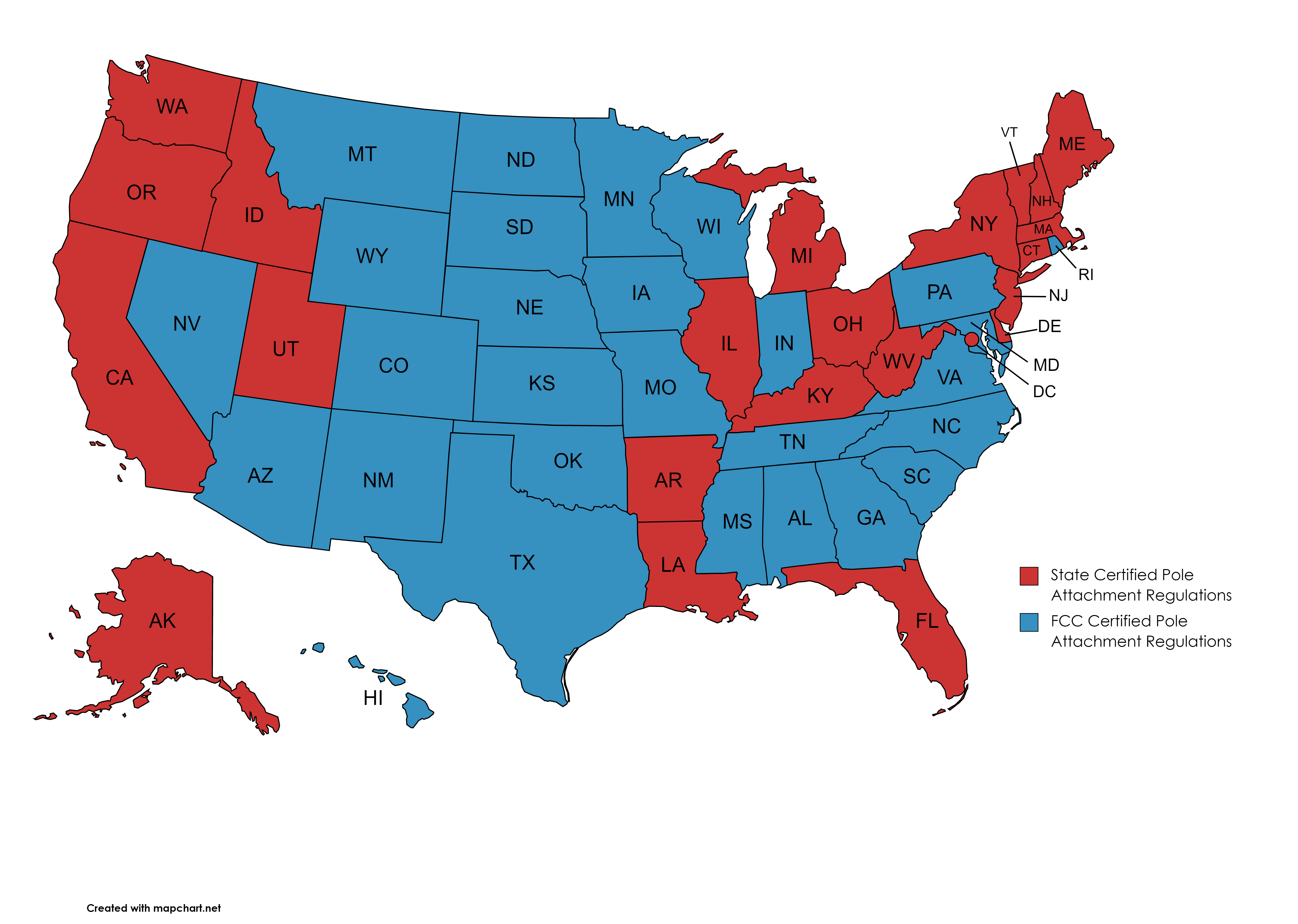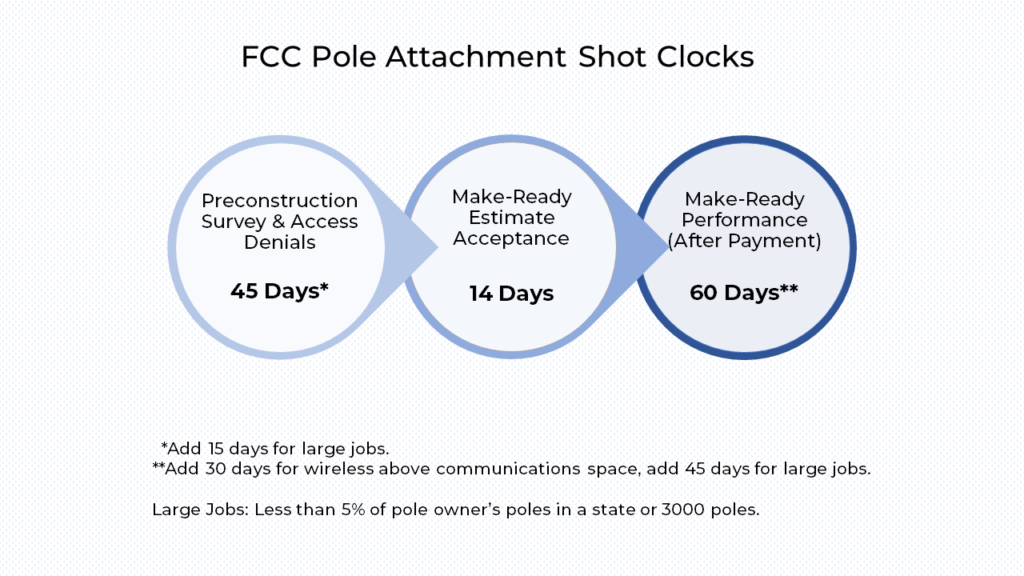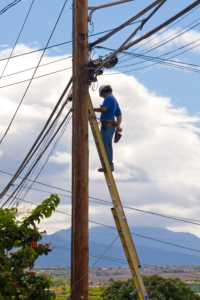
A Quick Reference Guide to Utility Pole Attachments
This article was written and published on July 7th, 2022. The information in this article is not intended to give actionable legal advice. The accuracy of this post may change at any time. Please refer to FCC-issued documentation for more information on all the contents contained herein.
Your utility is facing an unprecedented level of attachment requests. As Federal funding for national broadband deployment is being allocated to service providers, more requests come in daily. Staying on top of your permitting process is your priority, but you also know maximizing the efficiency and safety of your poles is critical.
The best methods of ensuring your poles are appropriately maintained and ready for attachers are familiarizing yourself with the FCC’s and your state’s pole attachment guidelines and investing in an automated solution for your permitting and maintenance processes.
In this article, we will lay out some of the power industry’s best practices and regulatory rulings concerning pole attachments. We’ll also explore an automated permitting solution, Varasset.
Jump to:
Overview of Attachment Guidelines
When the 1978 Pole Attachment Act (47 U.S. Code § 224) was written, it gave the FCC power to “regulate rates, terms, and conditions for pole attachments.” It also allowed states to become self-certified by developing their rates, terms, and guidelines for utility pole attachments. Thus not every state has the same guidelines about pole attachments. Some states follow FCC regulations, while others may be certified through state governance. Be sure to check whether your utility pole attachments are regulated by the FCC or by your state.

FCC Guidelines
Nondiscriminatory Access
The FCC encourages utilities to provide non-discriminatory access to any pole, duct, conduit, or right-of-way they own to the following types of attacher:
- Cable Systems
- Competitive Local Exchange Carriers (CLECs)
Access to your utility pole can only be denied if there is insufficient capacity or for safety, reliability, or other engineering reasons. Any attachment denials should be thoroughly documented.
Your utility can establish reasonable standards for access, but those standards cannot frustrate access, be applied retroactively, or be discriminatory. You can find the best practices for safety and reliability through the National Electrical Safety Code (NESC), which is used as a standard by the FCC for determining pole accessibility.
Utilities do have the ability to reserve space on their poles for future use. To reserve space, the utility should submit a development plan to the FCC that outlines the need for that space to ensure reliable service. This rule does not apply to Electric and Incumbent Local Exchange Carriers (ILECs).
Traditional and One-Touch Make Ready Overview
The most important aspect of attachment guidelines is how attachers can affix their components on your utility poles. Typically, attachers will make attachment requests by applying for a permit on your utility pole.
The pre-construction survey is vital as it allows you to check for unexpected attachments, pole health, safety, and other factors. Once submitted, it’s essential to ensure that your utility meets the timelines or shot clocks developed by the FCC to prevent any bottlenecks or possible financial penalties.

One-Touch Make Ready
In May 2019, the FCC implemented FCC Order 18-111 to “continue its efforts to promote broadband deployment and competition by speeding the process and reducing the costs of attaching new network facilities to utility poles.”
The central component of this order was creating a simplified make-ready process known as One-Touch Make Ready (OTMR). Essentially, your attachers and approved contractors can perform all attachment work, including moving communication equipment owned by your utility or other attachers, without unnecessary applications or waiting periods.
OTMR is only available as an option for cable television and non-ILEC attachers. Your OTMR-approved attachers are allowed to perform simple make-ready on telecommunications attachments exclusively.
You can learn more about One-Touch Make Ready here, on the FCC site.
Pole Replacements

The FCC has been working to ensure that attachers can access utility poles quickly, safely, and affordably. This is especially crucial because of the Federal push and subsequent funding to roll out nationwide broadband infrastructure. However, as utilities prepare for broadband attachers, they have discovered some of their poles need to be replaced to support said attachers.
In January 2021, the Wireline Competition Bureau found it was unreasonable for utilities to impose the total cost of pole replacement on attachers. There is an ongoing discussion regarding whether utilities will take on the total cost of replacing poles or whether attachers will share the cost.
You can learn more about this conversation here.
Overlashing
Overlashing, or the process of tying additional cables to preexisting attachments, is one method of attachment that telecom providers believe will accelerate broadband deployment. Under FCC rules, attachers are not required to get pole owner approval for overlashing as they don’t technically count as a new attachment. As a utility, you cannot charge attachers any rent for overlashed facilities unless they provide broadband or wireless services. However, tracking the overlashes on your utility poles is still essential, as their weight needs to be accounted for during maintenance, safety inspections, and pole-loading calculations.
Third parties can overlash on their own permitted facilities without pole owner permission, but they must notify the attacher. Overlashes must comply with your utility’s or FCC standards for safety and reliability. And, if the overlash delivers BIAS, it is required to pay for pole rental as it is considered an attachment.
Safety inspections
 There are three main rules regarding safety inspections for pole owners:
There are three main rules regarding safety inspections for pole owners:
- Post-construction inspections must be performed following any installations within a reasonable timeframe.
- Periodic inspections need to cover every attachment on the pole. Inspection cost must be covered by yearly rent charged to attachers.
- Non-periodic inspections can only be performed if your utility suspects an attacher is out of compliance.
If you discover one of your attachers is out of compliance, you may be able to charge them the cost of any violations caused solely by the attacher. In cases where fault between you and your attacher can’t be determined, you can opt to cost-share the price of the violation, but only if both parties agree.
Attachment Counting Audits
The FCC requires that utilities perform attachment counting audits once every five years. A pole audit may only commence once you have a list of each pole you will be inspecting, including pole number and location, and have notified all attachers on a given pole prior to inspection. This will allow your attachers to verify the existence of their attachment. This also allows your attachers to participate in an audit of their attachments alongside you.
There are two reasons to perform these audits:
- To ensure your billing records are up to date and account for all your billable attachments
- To discover any illegal, non-permitted attachments.
Fortunately, audit costs for your pole attachments should remain low, with estimations as low as $3 – $6 per pole in 2018.
Should you have unauthorized attachments on your poles, the FCC will allow you to charge the bootleg attacher up to five years of back rental fees. However, if your attacher declined to participate in the audit, the FCC will allow you to charge compensation of $100 per non-permitted attachment.
Varasset, your permitting solution
While it’s always good to have a “pole attachment best practices” guide at hand, your utility may need more help than that. That’s why we’ve created Varasset, the leading software solution for utility pole joint use management. With over 20 years in the power distribution industry, Varasset is uniquely suited to lighten your permitting load, streamline your asset management system, and centralize your databases.
Varasset puts the power back in your hands and takes tasks off your to-do list. It automates your permitting process, letting you handle the most critical aspects of a project while putting the rest on autopilot.
Click here to schedule a free demo with us and learn how we can help you take control of your pole management system.
CORRECTION: This article was corrected on 07/27/2022. Previously, the article stated that non-discriminatory access was provided to Wireless and Broadband Internet Access Service providers, which is inaccurate. Non-discriminatory access is available only to CLECs and Cable Systems. We have removed the line and regret the error.
